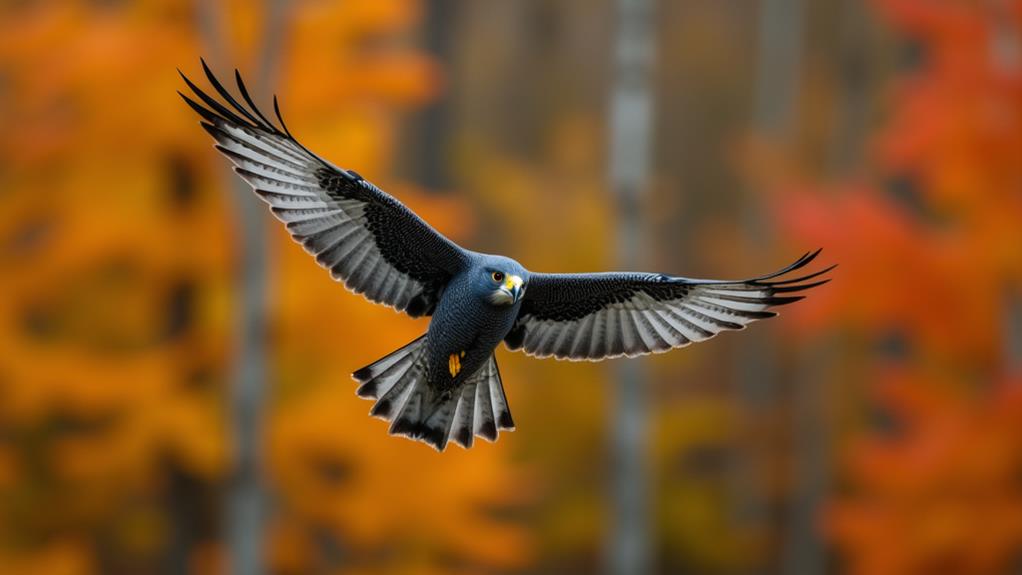You might be surprised to learn that Michigan is home to four distinct species of falcons. With their incredible adaptability and unique characteristics, it's no wonder these birds thrive in the state's diverse landscapes. From the urban jungle to open grasslands, each species has carved out its own niche. But what sets these birds apart from one another? How do Peregrine Falcons, American Kestrels, Merlins, and Gyrfalcons differ in terms of habitat, diet, and behavior? As you explore the world of Michigan's falcons, you'll discover the fascinating ways these birds have adapted to their environments.
Key Takeaways
- Peregrine Falcons thrive in Michigan's urban environments, utilizing artificial nesting sites on tall buildings or bridges.
- American Kestrels inhabit open grasslands and agricultural landscapes in Michigan, exploiting abundant small mammals and insects.
- Merlins migrate through Michigan, primarily in the spring and fall, breeding in the northern parts of North America.
- Gyrfalcons are typically found in northern Michigan, particularly in areas with open terrain and abundant prey, with partial migrations.
- Four species of falcons, including Peregrine Falcons, American Kestrels, Merlins, and Gyrfalcons, inhabit or migrate through Michigan.
Peregrine Falcons in Michigan

Pursuing recovery efforts in the 1980s, conservationists successfully reintroduced Peregrine Falcons into Michigan's ecosystem.
As you explore the state, you may notice these birds of prey thriving in urban environments. One key factor contributing to their success is the establishment of Peregrine nesting programs. These programs provide artificial nesting sites, typically on tall buildings or bridges, which mimic the falcons' natural cliffside habitats.
You'll find that Peregrine Falcons have adapted well to urban hunting. They prey on pigeons, doves, and other small to medium-sized birds, often using their agility and speed to pursue prey through city streets.
This adaptation is crucial to their survival, as it allows them to exploit a reliable food source in the midst of human development.
When observing Peregrine Falcons in Michigan, you may notice their unique hunting style. They typically use a "stooping" technique, diving from great heights to catch their prey off guard.
This technique is highly effective, allowing the falcons to thrive in urban environments. By understanding the Peregrine Falcons' nesting habits and hunting strategies, you can appreciate the conservation efforts that have enabled these magnificent birds to flourish in Michigan.
American Kestrel Habitat
As you continue to explore Michigan's diverse falcon population, you'll notice another species thriving in the state's varied landscapes: the American Kestrel.
The American Kestrel's habitat preferences play a crucial role in its distribution and abundance throughout Michigan. You'll find American Kestrels inhabiting open grasslands, including prairies and meadows, where they can hunt for small mammals and insects.
They also thrive in agricultural landscapes, such as fields and pastures, where they can exploit the abundance of prey species.
In both open grasslands and agricultural landscapes, American Kestrels typically require the presence of suitable nesting sites, such as tree cavities or rock crevices.
Human-made structures like nest boxes and building ledges can also provide alternative nesting sites, allowing the species to adapt to urban and suburban environments.
Michigan's diverse landscape offers a wide range of habitats suitable for American Kestrels, contributing to the species' widespread distribution throughout the state.
Understanding the American Kestrel's habitat preferences is essential for developing effective conservation strategies and managing its populations in Michigan.
Merlin Bird Species

What can you expect from the Merlin bird species in Michigan's diverse falcon population?
You'll find that the Merlin is a medium-sized falcon that migrates through Michigan, primarily in the spring and fall.
Merlin migration patterns typically involve traveling alone, often at night, and following the Great Lakes shoreline. They breed in the northern parts of North America, including Michigan's Upper Peninsula, and spend the winter months in the southern United States, Mexico, and Central America.
When it comes to Merlin nesting habits, you'll find that they don't build their own nests.
Instead, they take over existing nests from other birds, such as American Crows or Blue Jays. These nests are typically located in trees or on cliff faces, and the Merlins will add some twigs or other plant material to the existing structure.
Female Merlins will lay 2-4 eggs, which will be incubated for about 30 days. Both parents will help to care for the young, which will leave the nest after about 30-40 days.
Gyrfalcon Distribution Patterns
Within Michigan's vast falcon population, you'll find the Gyrfalcon's distribution patterns to be influenced by its Arctic and sub-Arctic origins.
As a result, Gyrfalcons are typically found in the northern parts of the state, particularly in areas with open terrain and abundant prey.
Gyrfalcons are known to be partial migrants, with some populations remaining in Michigan year-round, while others migrate to Canada and Alaska.
When they do migrate, Gyrfalcons often follow established migration routes, which can take them over long distances.
Some of the notable characteristics of Gyrfalcon distribution patterns in Michigan include:
- Wintering grounds: Gyrfalcons that migrate to Michigan typically winter in areas with open fields and abundant small mammals, such as voles and lemmings.
- Nesting habits: Gyrfalcons are known to nest on cliffs and rock outcroppings, often taking over existing nests from other birds of prey.
- Migration routes: Gyrfalcons that breed in Alaska and Canada migrate through Michigan, following established flyways, such as the Lake Michigan shoreline.
- Resident populations: Some Gyrfalcons remain in Michigan year-round, particularly in the western part of the Upper Peninsula, where they can be found in areas with open terrain and abundant prey.
Common Falcon Behaviors

Mastering gyrfalcon observations relies on identifying behavioral characteristics exhibited across all of Michigan's four major breeding bird falcons; however, understanding these behaviors can also provide insight into the lives of other falcon species in the state.
You'll notice that falcons are generally solitary birds, only coming together during breeding season.
Falcon socialization is primarily limited to mates and their offspring, with adults teaching young falcons essential survival skills.
When it comes to hunting, you'll observe that falcons employ various strategies to catch their prey.
Peregrine falcons, for example, are known for their swift dives, reaching speeds of up to 242 miles per hour.
American kestrels, on the other hand, use a "hover-hunt" strategy, scanning the ground below for small mammals and insects.
Gyrfalcons and merlins also employ unique hunting techniques, often using their agility and speed to catch birds in mid-air.
Frequently Asked Questions
Can Falcons Be Kept as Pets in Michigan?
You'll need to check Michigan's pet regulations regarding falcon ownership. Typically, falcons are protected birds, requiring special permits for private ownership. You must obtain a license from the Michigan Department of Natural Resources to keep a falcon as a pet.
How Do Falcons Protect Themselves From Predators?
You coincidentally notice that stealth tactics and camouflage strategies are crucial for falcons' survival. They employ agility and swift maneuvers to evade predators, while their mottled plumage and cryptic behavior help them blend into surroundings.
Are Falcons Endangered in the State of Michigan?
You'll find that habitat loss and population decline are key factors in determining a species' endangered status. In Michigan, some falcon species face these threats, but their conservation status varies, with some listed as endangered or special concern.
Can Falcons Be Found in Urban Areas of Michigan?
Fast-forward to city streets, you find urban dwellers coexisting with feathered friends. In Michigan, city habitats surprisingly support falcon populations, as adaptable birds claim concrete cliffs, utilizing urban structures for nesting and hunting sites effectively.
How Long Do Falcons Typically Live in the Wild?
You'll find that falcons typically live 2-3 years in the wild due to high mortality rates, but some species can reach up to 10-15 years; their wild lifespan varies greatly based on environmental and human-induced factors.
Conclusion
As you explore Michigan's diverse landscapes, you'll find four falcon species soaring through the skies like skilled musicians in a grand symphony. Each one – the Peregrine, American Kestrel, Merlin, and Gyrfalcon – plays its unique role, adapting to its environment with precision. Understanding their habitats, migration patterns, and behaviors will help you appreciate these magnificent birds of prey, and the vital part they play in Michigan's ecosystem.





